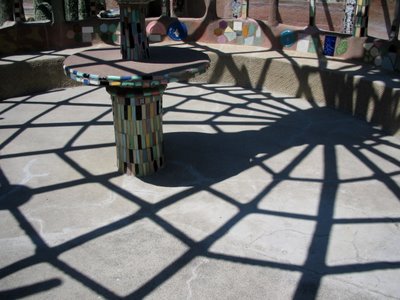Watts Towers


After many, many years of planning on visiting, this summer I finally made it to the Watts Towers. Of the single-obsessed-man folk art environments I've been to, it ranks pretty high. Below the Grotto of the Redemption in Iowa and Howard Finster's Garden of Eden in Georgia, but above everything else I can think of. It is truly impressive and the potential unity of the work, if critically defensible, might well make it the most interesting of the bunch. Our tour guide argued that the three main towers, placed in a row and inside of a larger oval shaped structure, signify the masts of a boat. If this is at all plausible--and if we could make some sense of why it would be a boat at all--then that would give the work an overall unity that no other such environments have. Maybe this sort of folk art isn't the sort of thing that has a unity, though; maybe it just isn't that sort of thing. Or maybe the only thing that unifies it is that it was all built by one dude, whose reasons remain pretty mysterious.
The most surprising thing about it, for me, was what surrounds it. There are some other houses along one side of it, but the three other sides are taken up by a big park, one that I don't think was originally there. The day we went, this sense of isolation was exaggerated by the sun: it was terribly bright out, without any shade at all, and this gave the whole place a very washed-out feel.
In the community center attached to it there was a seriously cool exhibit, put together by a local high school teacher. She was able to get a bunch of students to write about themselves, and she took accompanying photos of them and their lives. Apparently, she first did this over ten years ago, and then got the same people to re-describe their lives ten years later. Their handwritten comments were bound together into long books that folded-out, along with her photos. The autobiographical stuff they wrote was tremendously earnest, and moving. The whole exhibit was really impressive.
It made me think of the Oxford Project, although in some ways it was more moving. The photos weren't as good--they really didn't add anything to the autobiographical comments--but the comments themselves were more detailed, and seeing them written in the author's own hand was especially moving. As far as I could tell, it was put together entirely by a local teacher who eventually got some city funding; it would be cool it this sort of thing was done on a more widespread basis.
I've rented Wattstax from the local public library. I'm going to go watch it now, and finish drinking the rather mediocre homemade monkey toe I just made myself.

2 Comments:
I would like to add that the tour guide theatrically recited her living poem. She wrote about Watts Towers and their creator, Simon Rodia, and she choreographed movements to accompany her words and emotions.
True enough. If you go to see the Watts Towers, you've got to take the tour. If only for the "living poem" at the end.
Post a Comment
<< Home